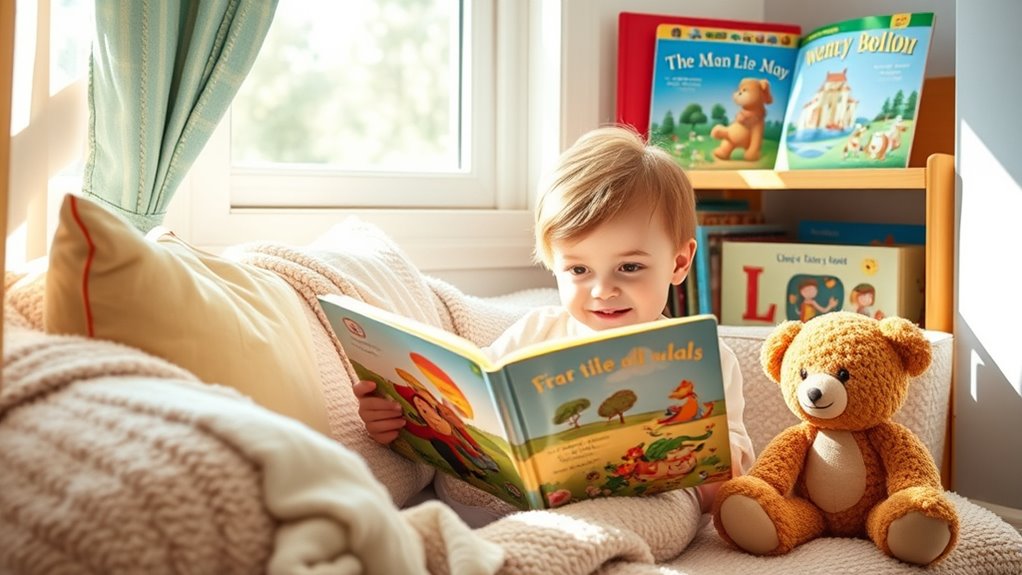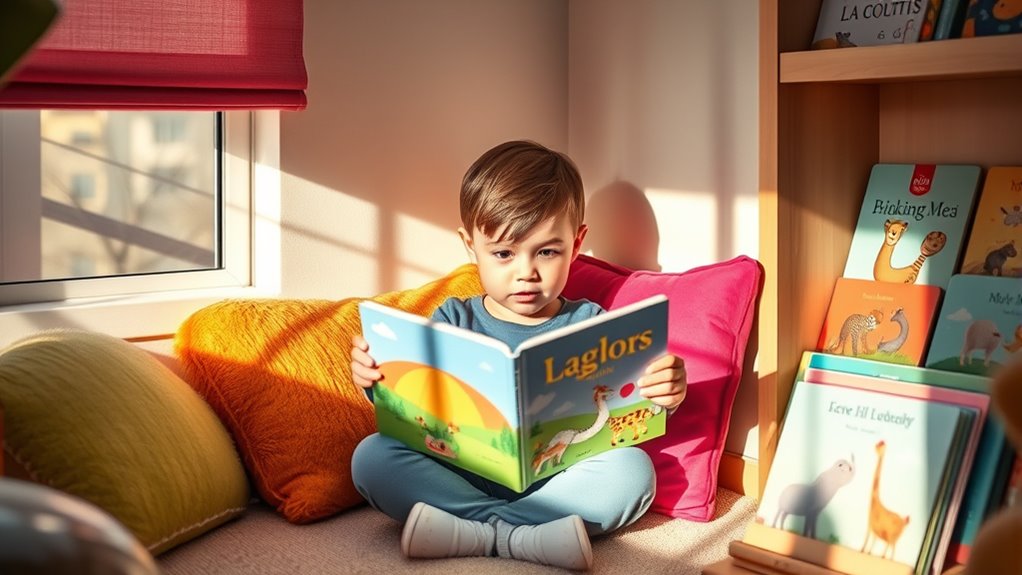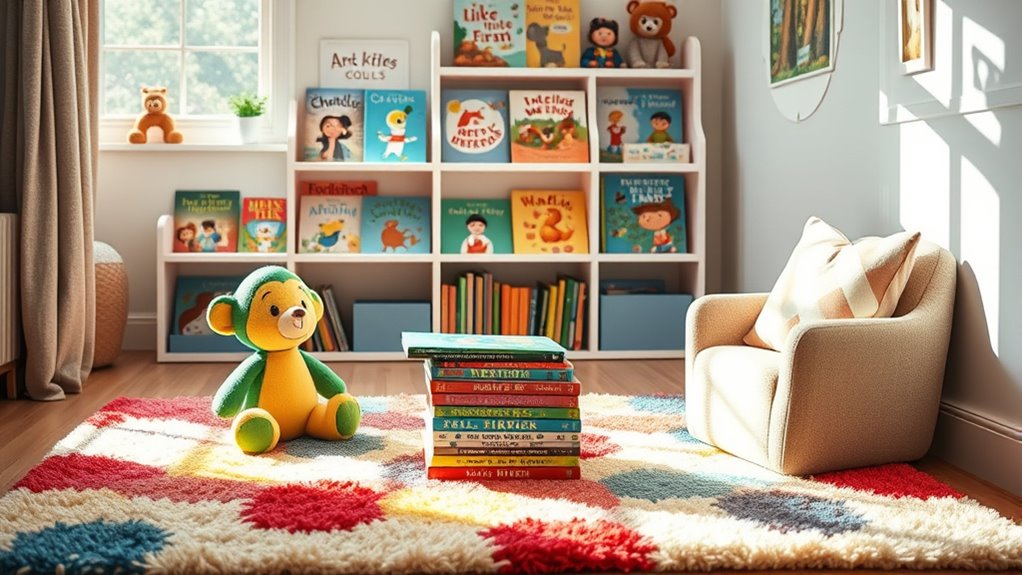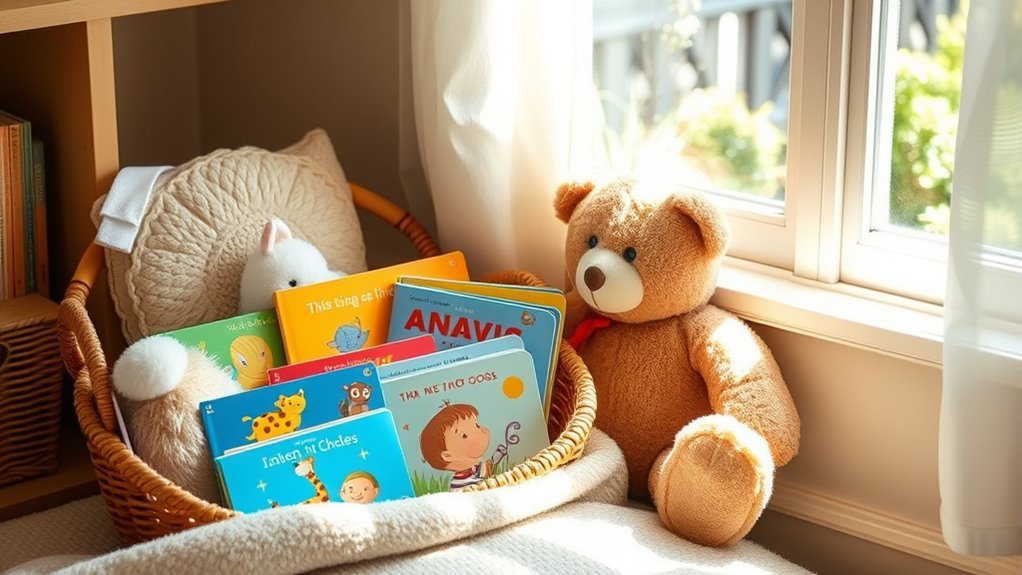Introducing toddlers to the best books is a fantastic way to foster their love for reading. Engaging stories with vibrant illustrations, like *The Very Hungry Caterpillar* and *Grumpy Bird*, will capture their attention. Use interactive books to make stories fun and encourage participation. Establish a daily routine to create positive experiences around stories. Kids thrive in a cozy reading environment with accessible books. Keep exploring to discover more tips on enriching their literary journey.
Key Takeaways
- Choose interactive and engaging books, like *Wheels on the Bus* and *Touch-and-Feel Flaps*, to captivate toddlers’ attention and enhance their reading experience.
- Incorporate classic titles such as *Guess How Much I Love You* and *The Very Hungry Caterpillar* for beautiful storytelling and visual appeal.
- Establish a daily reading routine, allowing toddlers to explore their interests and fostering a love for reading through familiarity.
- Create a cozy reading environment with accessible books and comfortable seating to encourage frequent reading sessions.
- Use open-ended questions during reading to stimulate curiosity and imagination, making the experience more engaging and enjoyable for toddlers.
Importance of Early Literacy

Understanding the importance of early literacy can set your child on a path toward lifelong success. When you engage in early literacy activities, you enhance your child’s reading skills and boost their academic potential. By incorporating educational toys into your child’s playtime, you further support their cognitive growth and language development. Research shows that exposing children to newborn feeding options can positively influence their overall development and readiness to learn. Additionally, implementing gentle methods for establishing routines can foster a sense of security that enhances learning experiences.
By introducing them to a language-rich environment, you prepare their brains for vital thinking and comprehension, laying a solid foundation for future learning. Proper nutrition, which is essential for brain development, further supports cognitive abilities that are critical for reading success. Without these essential skills, your child might face challenges in school that could limit their opportunities later on.
Creating a language-rich environment equips your child with essential skills for future learning and success.
Early literacy isn’t just about reading; it’s about fostering cognitive and language development, which are important for effective communication and problem-solving. Additionally, emotional and psychological growth plays a significant role in a child’s overall development and can be nurtured through storytelling and reading activities.
Investing time in reading now will pay off, ensuring your child thrives academically and socially throughout their life.
Strategies for Engaging Toddlers

Engaging toddlers during reading time can markedly enhance their early literacy skills. Use interactive books with flaps or textures to draw their attention. Incorporate props or toys related to the story for added fun. Ask questions about the plot to encourage participation, and motivate them to make gestures or sounds that match the story. Creating a lively atmosphere by reading outside or in cozy spaces can help maintain their interest, as social interaction is crucial for development. This engagement fosters mental potential that can lead to future creativity and problem-solving skills. Additionally, activities that promote balance and coordination can complement their overall development. Use different voices for characters and add sound effects to make storytelling more dynamic. Encouraging regular outings can help toddlers adapt to different environments, fostering their overall confidence. Encourage repetition of rhymes and phrases to boost their vocabulary. Finally, establish a daily reading routine, keeping sessions short and varied to match their attention spans and keep their interest alive. Additionally, ensure a safe sleep environment for toddlers to promote healthy rest, which is crucial for their overall development.
Recommended Books for Toddlers

Choosing the right books for toddlers can spark their imagination and foster a love for reading.
Classics like *Guess How Much I Love You* and *The Very Hungry Caterpillar* warm hearts with their beautiful storytelling and visuals.
Classics like *Guess How Much I Love You* and *The Very Hungry Caterpillar* enchant with heartwarming stories and stunning illustrations.
For vehicle enthusiasts, *Where Do Diggers Sleep at Night?* and *Pete the Cat and His Four Groovy Buttons* provide fun rhymes and counting.
Interactive options like *Wheels on the Bus* and *Touch-and-Feel Flaps* engage their senses.
If you’re looking for humor, *Grumpy Bird* and *Duck & Goose, 1, 2, 3* offer playful lessons.
Heartwarming tales such as *Full, Full, Full of Love* remind them of family connections.
These selections help create joyful reading moments together!
Building a Love for Reading

As you share stories with your toddler, you’re not just reading words—you’re building a lifelong love for reading. Create positive experiences by engaging through storytelling, using fun voices and expressions to bring stories to life.
Model your own reading habits to show that reading is enjoyable, and let your toddler choose books to foster their independence. Establish a daily reading routine to make reading a cherished part of their day. Engaging in daily reading can also enhance cognitive development as it stimulates imagination and critical thinking in young children.
Incorporate rhymes and music to enhance engagement, and don’t hesitate to revisit favorite books for comfort. Use open-ended questions to spark curiosity and imagination. Additionally, consider the importance of digital literacy programs to help children connect with stories through various mediums.
Selecting Age-Appropriate Books

Building a love for reading also involves selecting age-appropriate books that resonate with your toddler’s developmental stage. For infants, choose board books with high-contrast illustrations. As your little one grows, opt for touch-and-feel or lift-a-flap books to stimulate their senses and curiosity. For older toddlers, picture books with minimal text and vibrant images become ideal. Focus on stories featuring familiar characters and themes of friendship and sharing to engage their interest. Look for books with bold illustrations and interactive elements to keep them captivated. Additionally, selecting stories with strong character development can enhance their emotional understanding and connection to the narrative. Incorporating toys like the Montessori Busy Book can also reinforce the themes found in these stories and make learning more engaging. Creating a cozy reading nook with natural materials can also make storytime more inviting, fostering a love for books and learning. Engaging with shared experiences through reading can also strengthen their bond with caregivers, while incorporating vibrant images that reflect current trends can captivate their attention even further.
Interactive Reading Techniques

How can you make storytime more engaging for your toddler? Start by varying your voice tone and pitch to create an exciting atmosphere. Use different voices for characters, making the story relatable and fun.
Pause occasionally to let your toddler fill in words or phrases, boosting their participation. Incorporate movements or gestures related to the story to add a physical element. Engaging in storytelling through interactive techniques can enhance their overall experience. Additionally, fostering a digital-friendly environment at home can enrich their learning and reading experiences.
Ask open-ended questions about characters’ feelings and motivations, which encourages deeper thinking. You can even let them predict what might happen next.
Using props or puppets can enhance the storytelling experience, while discussing lessons learned reinforces comprehension. These interactive techniques not only engage your toddler but also foster a lasting love of reading, much like the importance of cookies in maintaining user engagement on websites.
Creating a Positive Reading Environment

Creating a positive reading environment is essential for nurturing your toddler’s love of books. Start by ensuring books are easily accessible; durable board books are perfect for little hands.
Set up a cozy reading space with comfortable seating and good lighting, making it inviting. You should also model reading behavior by sharing your own reading experiences and discussing books aloud. Engaging in creative practices like storytelling can further enhance your child’s connection to reading.
Minimize distractions like TVs or tablets to help your toddler focus. Adding thematic decorations related to books can engage their imagination.
Keeping a variety of books and rotating them often keeps the experience fresh. Building this environment encourages your child to explore and enjoy reading, laying the foundation for a lifelong love of books. Additionally, creating a space that reflects thematic decorations can further spark your child’s imagination and interest in stories.
Encouraging Independent Reading

While fostering a love for reading in your toddler, encouraging independent reading can be a game-changer. It enhances fluency and comprehension as they explore texts that spark their interest.
Start by choosing engaging books with simple sentences and vibrant illustrations. Consider using assistive tools like the MDA Avaz Reader to help them focus on one line at a time.
Choosing vibrant, engaging books with simple sentences can ignite your toddler’s love for reading and enhance their focus.
Establishing a daily reading routine reinforces good habits, while regular library visits allow your child to pick books that excite them, boosting their confidence.
You can also incorporate role-playing activities based on their favorite stories to deepen their interest.
Frequently Asked Questions
How Can I Introduce Books to My Toddler?
To introduce books to your toddler, start by choosing bright, colorful books with simple text.
Sit together in a cozy spot and let them turn the pages. Use different voices for characters to make stories come alive, and ask open-ended questions about the pictures.
Encourage them to guess what happens next or relate the story to their own experiences.
Keep the sessions short and fun, fostering a positive reading atmosphere.
What Age Should I Start Reading to My Child?
You should start reading to your child from birth.
Even infants benefit from early exposure to books, as it enhances cognitive and emotional development. Use simple board books with engaging pictures to capture their attention.
Establish a consistent reading routine, making it a cozy bonding experience. As they grow, choose age-appropriate stories that encourage participation.
Starting early sets the stage for a lifelong love of reading and learning, benefiting them greatly in the long run.
How Do I Choose Books That Fit My Child’s Interests?
When it comes to choosing books that’ll make your little one’s eyes light up, think of it as a delightful treasure hunt!
Start by exploring topics that spark their curiosity, like animals or vehicles. Pay attention to colorful illustrations and familiar themes that resonate with them.
Don’t shy away from interactive elements like lift-the-flap pages. By aligning stories with their interests, you’ll create a reading experience that’s not only fun but also meaningful!
Can Audiobooks Be Beneficial for Toddlers?
Absolutely, audiobooks can be incredibly beneficial for toddlers! They enhance listening comprehension and introduce new vocabulary, making it easier for your child to grasp complex concepts later.
What if My Toddler Loses Interest in Reading?
If your toddler loses interest in reading, don’t worry!
Try changing up the books you offer; choose ones that match their interests or include interactive elements like flaps or textures.
Create cozy reading spaces and limit screen time to make reading more appealing.
Incorporate storytelling games and allow them to pick their own books.
Establish a consistent reading routine to help rekindle that love for stories and make the experience fun and engaging!
Conclusion
In nurturing a love for reading, you’re not just sharing stories; you’re opening doors to endless possibilities. By engaging your toddler with age-appropriate books and interactive techniques, you’re planting seeds of imagination and curiosity that will flourish for years to come. Remember, every page turned is a step toward a brighter future, and your efforts now will shape their lifelong relationship with reading. So, embrace these moments together, and watch their love for books blossom beautifully.









